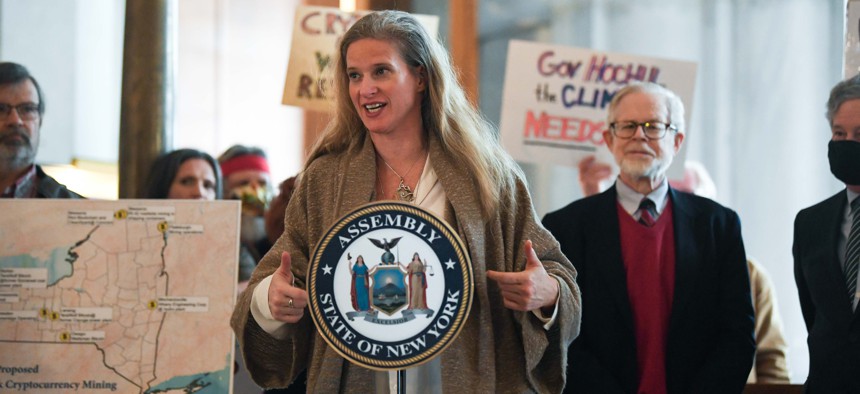Before 2017, New York was one of only two states to automatically prosecute 16- and 17-year-olds as adults. We won a huge victory for our state when we legally affirmed the importance of treating children as children by connecting them to support services and putting them on a healthier and more productive path. But it was more than a moral choice; passing Raise the Age followed decades of scientific evidence and best practices on public safety.
As New Yorkers increasingly worry about crime, our state is grappling with important questions about public safety. In these frenzied times people are looking to recent reforms – including Raise the Age – as a potential cause. Focusing on how to punish young people more severely, however, will not make our communities safer. In fact, research shows that relying on incarceration for safety, particularly for young people, backfires due to increased trauma, emotional and mental health issues, increased recidivism, and decreased overall public safety. We need new solutions for safety, and one of these solutions rests in finally properly implementing the act, not rolling it back.
Those calling for rollbacks have claimed that Raise the Age has resulted in increases in violence among those under the age of 18. However, the data shows that the act has made New Yorkers safer. Outside New York City, according to 2021 data from the New York State Division of Criminal Justice Statistics, in 2021, juvenile index crimes were down 64% compared to 2017, before the act’s implementation.
A recent report from John Jay College of Criminal Justice that analyzed New York Police Department data found that the share of violent crimes committed by people under 18 has generally gone down since the act was passed in 2017.
Critics have pointed to a New York Criminal Justice Agency report, which found that rearrest rates among 16-year olds increased 9% during the first year of the law’s implementation compared to the prior year, and that rearrest rates for violent felonies increased 10%. But everything rests in knowing how to actually read the data properly. During this same period, overall arrests among 16-year olds decreased by more than 35%, with misdemeanor arrests dropping more than 57%. The actual total number of rearrests among 16- and 17-year-olds decreased by 20% and the number of violent felony rearrests remained essentially flat. We should not confuse shifts in proportionality of groups within a population with the overall size of that population. Simply, individual pie slices shifted in size relative to other slices in an overall significantly smaller pie.
Some opponents have even pointed to increases in gun victimization in New York City to argue for rolling back the Raise the Age reforms. While there has been a modest increase in the number of people under 18 struck by gunfire, the total increase in victims also matches the national increases that we have seen since the beginning of the pandemic, including in places without recent criminal legal system reforms like Raise the Age.
For the crimes that most concern New Yorkers – including shooting or displaying a deadly weapon, or causing significant physical injury – young people are still processed in adult court, as was outlined in the act’s legislation.
Raise the Age is not a radical policy. The law does not let young people evade consequences for their actions. Rather, it acknowledges that accountability does not always and exclusively mean punishment; it’s about creating long term sustainable public safety for our communities. Family courts already use many tools to successfully break cycles of violence and crime, including counseling, intensive care management, and mentoring programs, as well as placement in residential facilities when the court considers this necessary. Crucially, it does not brand teenagers with permanent criminal records that can be life-long barriers to school, housing, jobs and true transformation of their lives..
Unfortunately, New York has failed to fully invest in the services young people need. The state has allocated $800 million over the last four years to implement the act’s reforms and, this year, the governor and the Legislature proposed another $250 million for implementation. However, bureaucratic rules and red tape have made it difficult for counties to access funds and have barred community-based organizations and service providers from applying for funds directly. Additionally, New York City, which represents half of the youth justice system, has been excluded from receiving state funding.
As a result, this money isn’t reaching the types of programs and resources that can actually prevent gun violence, as well as offer the support that our young people need, such as mental health, education, restorative justice and other trusted community-based programs proven to reduce violence.
The state needs to explore new ways to get this money out faster, including allowing communities to receive up-front allocations of Raise the Age implementation dollars based on information about the numbers of youth in each community who have contact with the criminal legal system.
Attacks on Raise the Age are about politics, not policy, and they rely on fear rather than data. Rolling back the act would erode our values without making our streets any safer. Instead, we should focus on and fully fund evidence-based solutions, not counterproductive rollbacks, for the wellbeing of our young adults and the safety of all New Yorkers.
Anna Kelles represents the 125th District in the New York State Assembly.
NEXT STORY: OPINION: Serving justice while limiting the collateral damage


